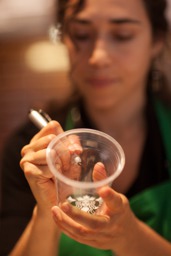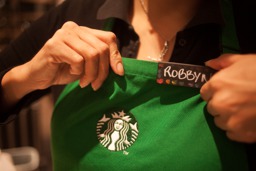Starbucks recently pledged to hire 10,000 refugees in its stores worldwide. In March 2017, Starbucks Canada committed to hiring 1,000 refugees over the next five years.
When asked why Starbucks is making this commitment, Luisa Girotto, Starbucks Canada Vice President of Public Affairs, says “Starbucks is particularly well placed to successfully hire refugees as we have existing hiring programs in place that address hiring people, specifically disconnected youth, who face challenges in finding opportunity. We are committed to being a leading employer of refugees in Canada. This resilient and highly-talented group of people are a valued addition to our teams as we have always been a place of inclusion, respectful dialogue and opportunity.”
 In April 2015 Starbucks Canada launched a program, in partnership with various levels of government and local social agencies, to take real action to tackle the country’s critical youth unemployment rates. The company took leadership position by committing 10 per cent of new store hires to Opportunity Youth, which are young people who are facing various systemic barriers to employment and require even more support in finding pathways to opportunity. The program which started in Toronto has expanded to Montreal, Vancouver and Calgary, with more cities to come. Girotto believes Starbucks will have the same success and impact among refugees to Canada.
In April 2015 Starbucks Canada launched a program, in partnership with various levels of government and local social agencies, to take real action to tackle the country’s critical youth unemployment rates. The company took leadership position by committing 10 per cent of new store hires to Opportunity Youth, which are young people who are facing various systemic barriers to employment and require even more support in finding pathways to opportunity. The program which started in Toronto has expanded to Montreal, Vancouver and Calgary, with more cities to come. Girotto believes Starbucks will have the same success and impact among refugees to Canada.
Collective Impact
Starbucks reached out to Hire Immigrants as their national partner in this ambitious effort. As part of the Syrian Refugees Jobs Agenda Roundtable, Starbucks is working with other employers and community partners to share, learn and scale employment solutions for former refugees.
Starbucks isn’t trying to do this by themselves. When government, community groups and employers come together, Girotto says that all partners can leverage their expertise and efforts for refugee employment success.
Working through Hire Immigrants, Starbucks will identify and connect with local refugee-serving agencies in each key city/market where it has stores. City by city, Starbucks will work with local agencies to identify candidates and create opportunities.
Meet and Greet
In its work with youth, Starbucks has found the high touch approach to have high impact. They created a Meet & Greet model that helps job candidates better understand Starbucks. It gives the company and candidates the time and space to explore what Starbucks is looking for in new hires, the work culture, and what success looks like at the company. It’s a safe environment where no one is being evaluated. Girotto says it helps Starbucks employees get to know candidates in a personal and friendly way.
She says this approach removes barriers that could potentially get in the way of someone applying through Starbucks’ software-based application system. It streamlines the flow of potential candidates to the company. Together with community partners who identify clients most likely to be interested and ready, the company can connect with people and help them understand the opportunities, and what they need to make the leap to employment.
Many employees show interest to volunteer at these events, showcasing how this commitment has engaged Starbucks employees. Girotto says that what employees take away is huge. The first refugee Meet & Greet with Syrian refugees, hosted by ACCES Employment on May 31st, was overwhelming from an emotional point of view. Every Starbucks partner who attended came away feeling proud and rewarded.
When it comes to former refugees, Girotto says they are looking for skills, personality, learning agility, and Emotional Intelligence (EQ), not job experience. The Meet & Greet allows company staff to meet people and experience who they are in a friendly environment. For the former refugees, it is way to connect with a potential employer in an unfamiliar labour market.
Bigger than Corporate Social Responsibility
Always in person, always one-on-one, these sessions have resulted in an astronomical return on investment in the Opportunity Youth program. Girotto says corporate job fairs typically measure success when 10% of attendees are eventually offered a job. In the Starbucks’ Meet & Greet model 50-90% of participants are offered a job. She thinks the company can replicate this success in its refugee Meet & Greet sessions.
Ultimately, the sessions are a small investment for the company. Barriers for potential hires are removed. Community partners like ACCES know the candidates, and will know who to refer to the Meet & Greet with an eye for success. The turn around from Meet & Greet to interviews takes days, not weeks. Candidates can be offered a job and begin training within a short period of time.
 Those hired gain secure employment, but also benefits that exceed what most workers find in the industry. Starbucks provides part-time employees, working a minimum of 20 hours per week, with “full-time” benefits including; health, dental, tuition reimbursements, company stocks, future savings, career and personal support services. The company also offers an Employee Assistance Plan (EAP) to all employees which provides mental health support, including short-term services. Most recently, they increased their mental health benefits to $5,000 per year for all eligible employees, who work a minimum of 20 hours per week, and their dependents.
Those hired gain secure employment, but also benefits that exceed what most workers find in the industry. Starbucks provides part-time employees, working a minimum of 20 hours per week, with “full-time” benefits including; health, dental, tuition reimbursements, company stocks, future savings, career and personal support services. The company also offers an Employee Assistance Plan (EAP) to all employees which provides mental health support, including short-term services. Most recently, they increased their mental health benefits to $5,000 per year for all eligible employees, who work a minimum of 20 hours per week, and their dependents.
Starbucks has found that their approach has also translated into greater staff retention. Workers who participate feel they work for a company that cares about its communities. Building a secure, passionate and loyal workforce is also a win for Starbucks. It’s a model that can work for other employers as well.
Tips for making it work for you:
- Agencies are there to make things easy. Work with local agencies. The services available to refugees/newcomers are significant. It may require far less effort than an employer thinks to move from identifying talent, to recruiting, to have a successful job offer. You’ll feel good about it, and experience has meant lower staff turnover at Starbucks.
- Understand and incorporate the unique needs of refugee job-seekers into your recruitment. All groups have unique needs, including refugees. The more you can reach out and connect in a way that is meaningful, safe and practical for refugees, the more candidates you will attract.
- Look at other successful employment models, and replicate. You may have your own previous success with recruiting and hiring from a disadvantaged group. Look at how you can replicate your success with refugees. If you don’t have internal models, look around you at other employers, within and outside of your industry. You’ll find a landscape of plentiful ideas, resources and formulas to help you access skilled refugee talent.
Read more Success Stories from the Syrian Refugees Jobs Agenda Roundtable
